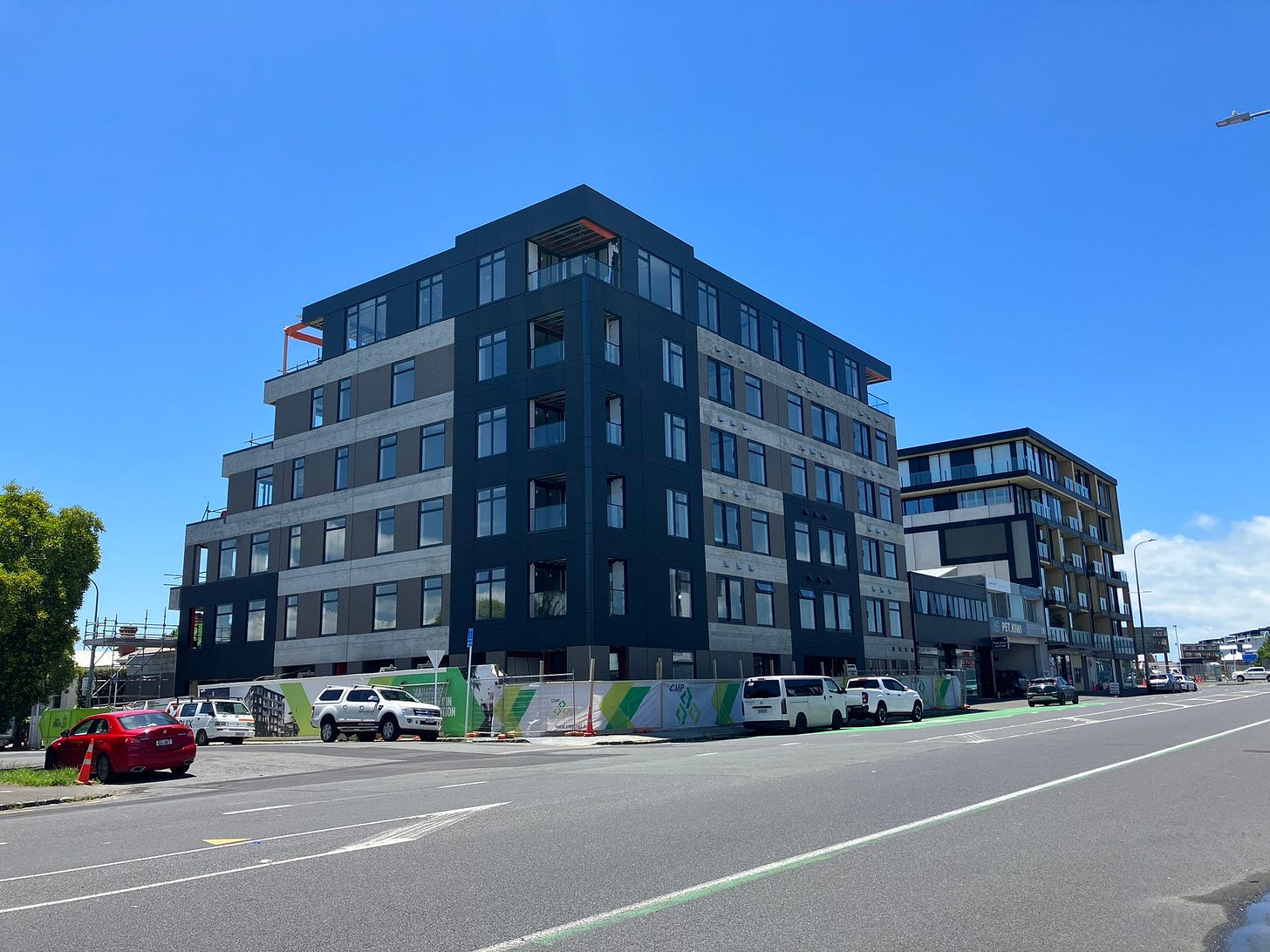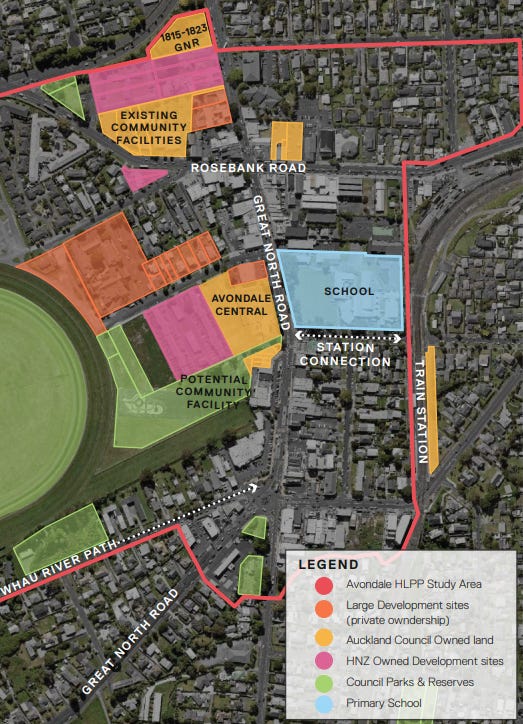The tale of two TODs
The contrasting story of transit oriented development in New Lynn and Avondale

Transit oriented development is a hot topic in New Zealand and around the world. By locating more people, both working and living, close to rapid and frequent public transport, we can improve livelihoods while supporting other goals like reducing emissions from transport.
The story of New Lynn and Avondale is one of great comparison in the approaches and outcomes delivered and there are lessons to be learnt from both.
Firstly, what is Transit Oriented Development?
There is a broad subset of literature focused on defining TOD. However, in simple terms, TOD is generally considered as medium to high density, mixed-used development centred around a rapid transit station.
The term can refer to a single building, like an over-site development (OSD), as planned over Te Waihorotiu Station in Auckland. It can also be used to describe a neighbourhood set around public transport.
Typically, TOD is used in cases where there is rapid transit, a railway or a busway. However, it should be understood there is a lower scale of TOD, where you see medium-density development close to frequent bus routes with significant, if not complete, levels of bus priority, that enable faster and more reliable journey times. For example, apartments along Dominion and Great North Roads in Auckland fit this category. This scale of TOD is applicable in a far broader subset of urban environments, not just major cities.
New Lynn Transit Oriented Development
On the face of it, the New Lynn Transit Oriented Development had it all. It was a core element in a comprehensive plan, the New Lynn Urban Plan, to reimagine New Lynn from the ground up, centred on trenching rail to reduce severance and making a bus rail interchange the anchor for comprehensive redevelopment. It had many of the key success factors for urban regeneration, such as a single-minded focus, a lead agency with planning powers and a dedicated and passionate project team.
What was initially delivered between 2010 and 2012 was promising. A state-of-the-art bus/ rail interchange, along with bus network changes, helped grow patronage of the station and wider network significantly since the opening. New Lynn was the third busiest station, behind Newmarket and Britomart, on the network until 2019, when it was overtaken by Panmure, another bus-rail interchange success story. Coordinated with the new station and grade separation of the rail line was a three-storey commercial development and an apartment tower next to the station.
However, not much has happened since. The birth of the super city put paid to the place-based focus on areas not in the ambit of Eke Panuku, Kāinga Ora or the Tāmaki Regeneration Company. Attempts to reduce or eliminate minimum parking requirements were stymied for over nine years by legal action by supermarket chains and big box retailers, enabling surrounding development to become a car-oriented mess that would make Lincoln Road proud. Key brownfield sites such as Crown Lynn and Monier Brickworks lay fallow for many years and are now only slowly starting to regenerate. And planning failed to address the elephant in the room of LynnMall, which sucked the energy out of surrounding of the surrounding streets and in turn failed to address or orient itself to the bus/ rail interchange and TOD.
While there have been many regeneration proposals over the years including Kiwi Property and Kāinga Ora, little has been delivered. The opening of City Rail Link, set down for 2026, will bring New Lynn much closer to the city centre by rail. This may be the trigger for New Lynn to become market-attractive but, in the meantime, one station up the road in Avondale, a lot more action has already been seen…
Avondale Town Centre Regeneration
The Avondale Town Centre regeneration project is a programme by Eke Panuku (the Auckland Council development agency) to develop Auckland Council owned land and coordinate social housing development and local streetscape improvements to support the town centre.
This is not often stated as a Transit Oriented Development project. In contrast to New Lynn, Avondale hasn’t had the same focus on transport infrastructure but “the bones are there” with the location and existing public transport options. The Avondale Train Station has services every 10 minutes in the peak and 20 minutes until late evening. Like New Lynn, Avondale will benefit significantly from the opening of the City Rail Link, but it also has multiple frequent (every 15 minutes) bus routes, along with other connector services. This provides a high level of public transport accessibility to the wider city.
While the bones are there, the real story in Avondale is land use change, which has been far more pronounced with a consistent focus by Eke Panuku to work with Kāinga Ora and private developers to deliver new medium-density residential development in the Town Centre.
Auckland Council had some, limited land holdings, which has provided a base for Eke Panuku to enter development agreements for medium to high-density developments, conduct land swaps and site amalgamations. Developments in the Town Centre include:
1817 Great North Road is now home to the Aroha apartments by Ockham. Here, Eke Panuku were able to enter a development agreement to push higher density development and smaller apartments to fit within the Kiwibuild first home buyer caps. In total delivering 117 homes.
This has been cleverly coordinated with the soon-to-be-completed Kāinga Ora Highbury Triangle development next door, which is delivering 236 new elderly housing units, sharing a new laneway between Great North Road and Tait Park. As I have covered previously, Kāinga Ora relocating elderly housing into Town Centres is a great policy, supporting residents to have more independence and access through transit and walkable locations.
Kāinga Ora is also in the procurement process for the construction of 137 apartments on a large block at 18 Elm St & 17 Racecourse Parade. This site was previously the Auckland International College boarding house and was acquired by Eke Panuku in 2016.
Manawa (going through the resource consent process) is a planned 750-apartment development by Ockham Residential. The site was previously split in ownership but Eke Panuku amalgamated two properties through effectively a land swap with Kāinga Ora for the 10 Racecourse Parade and the Elm Street site noted above.
Along with previously completed developments, including 72 apartments in the Set development on Racecourse Parade, and other consented market developments nearby, there is significant intensification occurring in the Avondale Town Centre and across the wider suburb.

So, what can we learn from this?
Having agencies like Eke Panuku take ‘ownership’ of a centre and work to advance development and community outcomes can be significant for coordinating public and private projects. In New Lynn, Eke Panuku is currently marketing one site but having an organisation take ownership of the wider centre could support urban regeneration. Site amalgamations could be helpful for stimulating development on the older light industrial properties beside the New Lynn rail trench. Eke Panuku can compulsorily purchase land for urban renewal. However, it is worth noting this is not frequently used due to financial limitations with just a $100m development fund available. Access to capital is critical for undertaking site amalgamation and shaping better development opportunities.
While the original New Lynn TOD project addressed many key issues around the station, there are still further improvements to be made. Cycle network improvements for accessing the New Lynn Station are planned to be funded through the Auckland Council - Climate Action Targeted Rate. Meanwhile, New Lynn station is nearing capacity for buses and with planned service improvements in West Auckland, more stops and layover space will be required. Coordinating these with other public space improvements and urban development can help create a stronger urban centre.
In Avondale, the emerging development story is fantastic. It’s worth noting that Avondale is closer to the Auckland City Centre, the proximity of which, may be driving higher demand for housing and help make developments like Aroha, more viable. However, work done in Avondale to advance development has certainly contributed to more homes being built and greater master planning is delivering better design outcomes.
There are other challenges, for Avondale, which lie with the public sector. These include:
Rail improvements, including grade separating level crossings, which are critical for planned service improvements, along with station upgrades and bus priority for the many bus routes that converge on the centre.
Town centre and station access improvements, particularly for cycling and micromobility.
Town Centre enhancements that improve local amenities will become more important to support the centre and surrounding neighbourhoods as the population grows. The new community centre and library is a good start on this.
The original New Lynn TOD project was successful in coordinating all three elements to some extent.
In summary, New Lynn received coordinated infrastructure improvements to support TOD but the development largely hasn’t followed. One stop up the line, Avondale hasn’t had the same scale of infrastructure investment but a targeted development programme by Eke Panuku has seen far greater development delivered, planned and consented.
In developing TOD, many factors contribute to the end product. Enabling market development through upzoning is key, while redeveloping underutilised council or government land can also provide a significant opportunity. However, without public investment in public transport services, infrastructure and public amenities, broader outcomes including mode shift and emissions reductions are unlikely to be realised. Equally, less investment in public transport and infrastructure will likely be a handbrake to some extent on development.
This interdependency is why it can be important to have guiding agencies take “ownership” of centres like Avondale. As we see greater development enabled around key centres and rapid transit, on the back of the National Policy Statement on Urban Development, supporting measures for intensification need to be considered. New Lynn and Avondale provide great lessons in this for key centres elsewhere in Auckland and other cities around the country.







